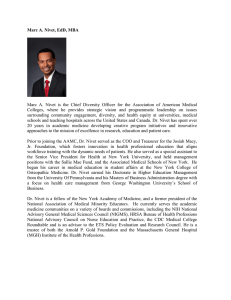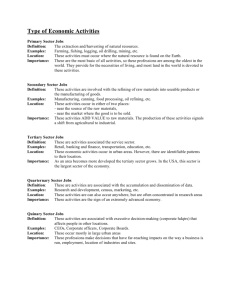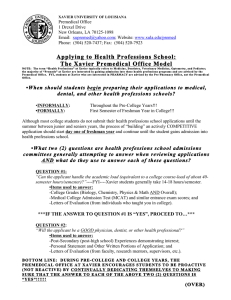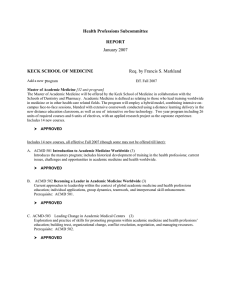A The Academic Health Center: Evolving
advertisement
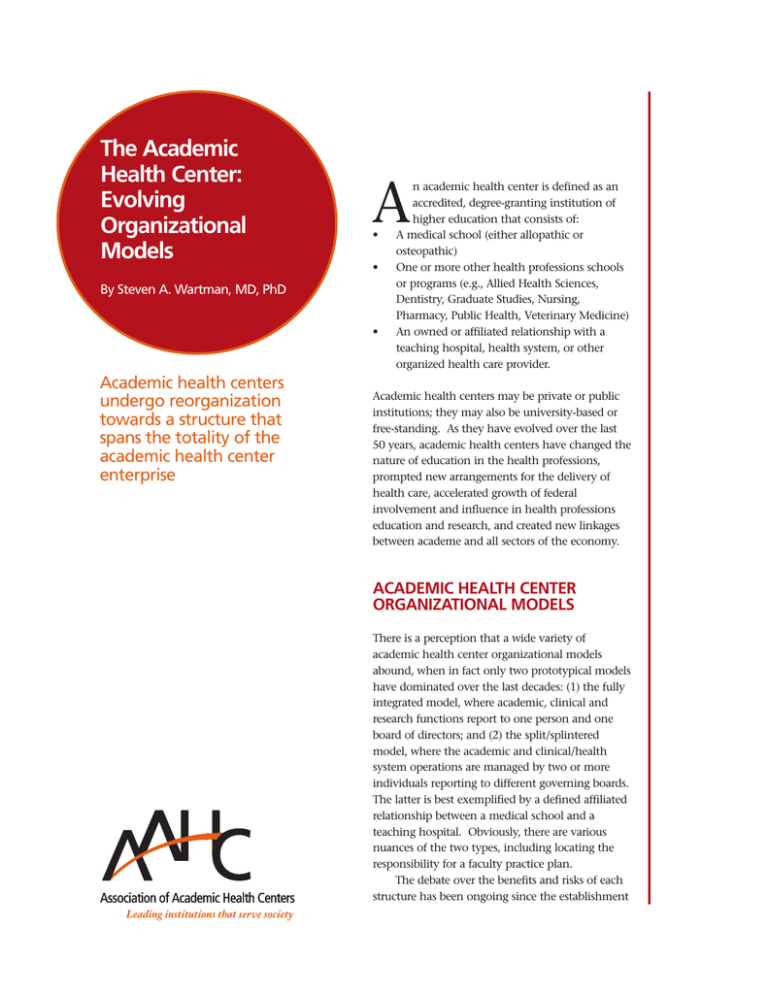
The Academic Health Center: Evolving Organizational Models A • • By Steven A. Wartman, MD, PhD • Academic health centers undergo reorganization towards a structure that spans the totality of the academic health center enterprise n academic health center is defined as an accredited, degree-granting institution of higher education that consists of: A medical school (either allopathic or osteopathic) One or more other health professions schools or programs (e.g., Allied Health Sciences, Dentistry, Graduate Studies, Nursing, Pharmacy, Public Health, Veterinary Medicine) An owned or affiliated relationship with a teaching hospital, health system, or other organized health care provider. Academic health centers may be private or public institutions; they may also be university-based or free-standing. As they have evolved over the last 50 years, academic health centers have changed the nature of education in the health professions, prompted new arrangements for the delivery of health care, accelerated growth of federal involvement and influence in health professions education and research, and created new linkages between academe and all sectors of the economy. ACADEMIC HEALTH CENTER ORGANIZATIONAL MODELS Association of Academic Health Centers Leading institutions that serve society There is a perception that a wide variety of academic health center organizational models abound, when in fact only two prototypical models have dominated over the last decades: (1) the fully integrated model, where academic, clinical and research functions report to one person and one board of directors; and (2) the split/splintered model, where the academic and clinical/health system operations are managed by two or more individuals reporting to different governing boards. The latter is best exemplified by a defined affiliated relationship between a medical school and a teaching hospital. Obviously, there are various nuances of the two types, including locating the responsibility for a faculty practice plan. The debate over the benefits and risks of each structure has been ongoing since the establishment ASSOCIATION OF ACADEMIC HEALTH CENTERS “Ultimately, the type of model existing at a given institution reflects a combination of history, politics, and economics.” of academic health centers in the late 1960s, when it was considered quite necessary to have an integrated system. With the advent of managed care and changes in reimbursement systems for patient care in the 1980s, there was a growing perception that business effectiveness and efficiencies could best be achieved by separating the clinical enterprise from the other mission areas. Occasionally, the organization of some academic health centers cycled between these two models, depending on the local economy, health market trends, university politics or personalities of the leaders involved. Ultimately, the type of model existing at a given institution reflects a combination of history, politics, and economics. CURRENT TRENDS EVOLVING ORGANIZATIONAL MODELS 2 Today, academic health centers are recognized as national economic engines and complex business enterprises. In increasingly competitive national and global economies, they must achieve unprecedented scales of efficiency and agility in their mission areas of education, patient care, and research in order to grow and flourish. Failure to do so will result in a struggle to maintain the status quo. The major response of academic health centers thus far to these challenges has been a trend towards more “corporate” management. In recent visits to a substantial number of academic health centers, it is clear that this management transition is in varying stages (depending on the particular institution) but is essentially characterized by a reorganization along non-disciplinary lines towards an administrative structure that spans conceptually and operationally the totality of the academic health center enterprise and encompasses all mission areas. The result has been expanded roles for existing positions (such as vice presidents for health affairs) or the creation of new roles (e.g., academic health center-wide compliance officers or vice presidents for research) that extend beyond the individual health professions schools, along with a greater emphasis on team-oriented approaches to strategic planning, operations, and problem-solving. Findings from a survey of one half of the AAHC members in 2005 found that in 78% of responding institutions that owned a teaching hospital, the academic health center leader had sole authority over the head of the hospital. Seventythree percent of leaders at institutions that owned a health system said they had sole authority over the head of the health system. And 14% of the responding academic health center leaders served as both the academic health center president (or equivalent title) and CEO or vice president of the health system or medical center. The topic of academic health centers being a fully integrated enterprise, including the clinical component, under a single leader and a single board is now emerging as a major issue. Other features of “corporate” management for academic health centers include markedly increased efforts to relate to stakeholders (i.e., the public, patients, practitioners, politicians, policymakers, and business community); an international focus to increase global competitiveness; enhanced programs in translational and applied research in response to the growing pressure to accelerate the translation of biomedical research into practical implementation; and, focused business operations with enhanced strategic planning, new methods of budgeting and more rigorous assessment and accountability for faculty, staff, and administration. CONCLUSION In the years ahead, a continuing horizontalization and consolidation of the academic health center enterprise throughout its mission and management areas will be apparent. As this happens, academic health centers will undergo a process of accelerated change as the result of strategic planning processes that drive leaders to make the hard decisions about “Academic health centers will undergo a process of accelerated change as the result of strategic planning processes that drive leaders to make the hard decisions about resource allocation.” ASSOCIATION OF ACADEMIC HEALTH CENTERS resource allocation. These changes are essential to ensure accountability at higher levels of authority as well as buy-in from faculty and staff, who must adapt to new rules that involve more interdisciplinary collaboration and institutional team play. In academic health centers that are not fully integrated with their clinical enterprise, there is the potential for heightened conflict with their clinical partner as their strategic visions may vary. It is increasingly evident that with regard to future academic health center growth and development, particularly in the research and patient care arenas, an integrated system provides the structure to increase benefits, decrease financial risks, advance scientific progress, and heighten the institution’s reputation and trust with the public in a more efficient and organized fashion. It is critical that the new “corporate” paradigm not overshadow the fundamental academic ethos and the creativity, intellectual spirit and unique public standing of these institutions. It has never been more important for the academic health center enterprise to take to heart the full implications of the societal missions of their institutions as they evolve into global competitive enterprises. The greater public good—which means balancing all mission areas to serve the public— must always be the raison d’etre behind the organization and structure of the academic health center for the future. Steven A. Wartman, MD, PhD, MACP, is president and CEO of the Association of Academic Health Centers. EVOLVING ORGANIZATIONAL MODELS 3 Association of Academic Health Centers Leading institutions that serve society VISION To advance the nation’s well-being through the vigorous leadership of academic health centers. MISSION To improve the nation’s health care system by mobilizing and enhancing the strengths and resources of the academic health center enterprise in health professions education, patient care, and research. 1400 Sixteenth Street, NW, Suite 720 Washington, DC 20036 202.265.9600 202.265.7514 fax www.aahcdc.org © 2007 by the Association of Academic Health Centers
